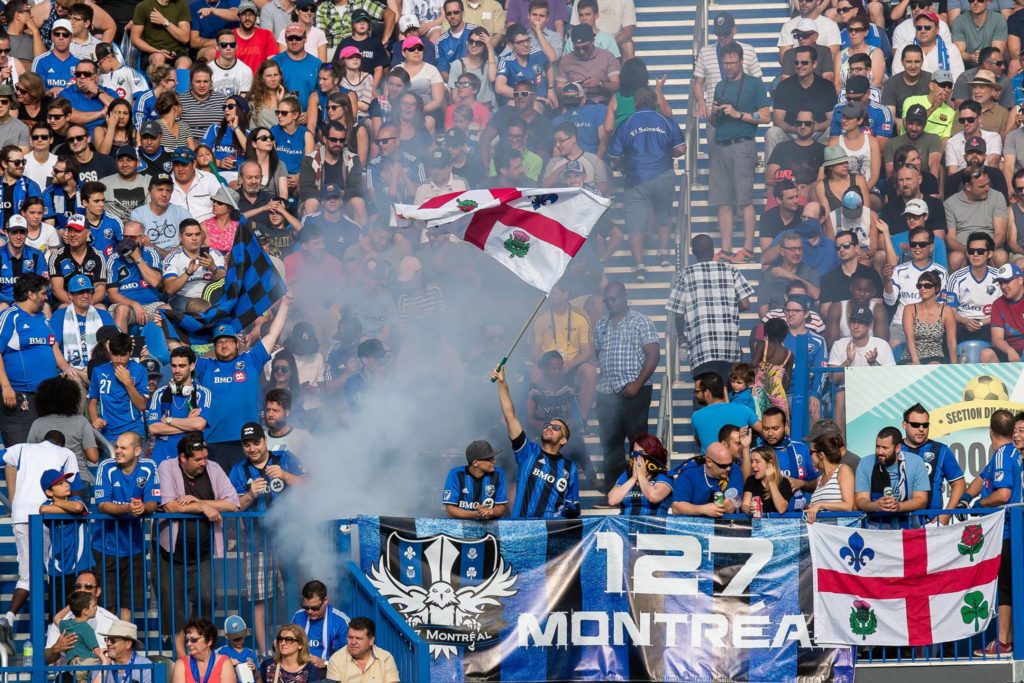It has been a good summer for soccer in Montreal.
In less than five years, the Canadian city has gone from a second-tier soccer outpost to a major center of the development of the North American game. With its modern facilities, global superstars, and active fan base, Montreal is demonstrating the growth potential of the beautiful game on this side of the Atlantic.
The explosive growth of soccer in Montreal can be traced initially to the inclusion of the Impact as the MLS’s 19th franchise, beginning league play in 2012.
The Impact franchise actually has a long history – it was founded in 1992 playing in the American Professional Soccer League, which folded when MLS was founded in 1996. The Impact, however, joined the A League (later the USL First Division, then the USSF D2 Pro League), where they played until 2010. They played the 2011 season in the NASL before joining Major League Soccer.
Until 2007, crowds for Impact games were small, as they played at the multi-sport Claude-Robillard Sports Complex. In 2007, their last season there, home attendance averaged 7,186.
The promotion of the Impact to MLS was driven in large part by the construction of Saputo Stadium, opened in 2008. As the team was second division at the time, the $17 million dollar stadium was built with a capacity of just over 13,000. It was built in the shadow of the Olympic Stadium on the grounds of the 1976 Summer Olympics, in an area which served as practice fields during the games.
Once the deal was struck for the Impact to join MLS, the stadium was renovated at a cost of $23 million, bringing it to its current capacity of 20,801. It is the second largest soccer-specific stadium in Canada, after BMO Field in Toronto.
Just two years ago, the Impact also built a state-of-the-art $16 million dollar training facility, the Centre Nutrilait. It houses the Impact’s U8-U18 academy teams, their USL franchise FC Montreal, and the MLS first team. The facility, originally a fire station built in 1915, has classrooms, physio rooms, a gym, kitchen, offices for the club, and four training pitches – two grass and two artificial.
The Centre Nutrilait has further cemented Montreal as a global soccer hub. Premier League giants Chelsea FC used the facility during their North American tour in 2015, and this summer, Champions League winners Real Madrid made it their off-season training center during their tour in late July. Impact President Joey Saputo said, “It truly speaks of the quality of our facilities, and we’re thrilled that it places Montreal on the forefront of the international soccer scene.”
In addition to facilities, there is no question that star power, in the form of Ivorian striker Didier Drogba, has played a large part in the game’s recent revival in the city.
After an initial “honeymoon” period, which saw the Impact 3rd in the league in attendance in their first year in MLS in 2012 (22,772 average per game – due in part to their first 6 home games being held at the much larger Olympic Stadium) and 4th in 2013 (20,603), attendance had dropped off in recent years. In 2014, the year before they signed Drogba, the Impact had dropped to 14th in the league in per game attendance (17,750).
The Impact AD (After Drogba), however, has been a great story. Before his signing, attendance was continuing to fall – in June of 2015 against Canadian rivals Vancouver, only 10,035 fans saw the game. After Drogba arrived and started playing in August, the team sold out four of its final five home games of the season.
So far in 2016, the Impact is 7th in the league in attendance, averaging over 21,000 per game. It is a remarkable rebound, and the excitement of the international superstar Drogba has been the main driver. The team sits in 5th place in the Eastern Conference, and is shooting for a playoff appearance to continue the momentum.
In fact, beyond MLS attendance, many signs are indicative of the growth of Montreal as a soccer city.
The Impact reached the final of the 2015 CONCACAF Champions League, drawing 61,000 fans in the home leg game against Mexican Liga MX team Club America in the Olympic Stadium.
A 2016 summer friendly between the Impact and Italian giant AS Roma sold out Saputo stadium, with fans flocking to the stadium to catch a glimpse of Italian legend Francesco Totti.
Even youth soccer is growing in Montreal – the Brossard Challenge Cup, a tournament started in 1986 with 24 teams, saw 200 youth teams competing on 19 fields across the city this summer. There was also the construction of soccer facility at the Saint-Michel Environmental Complex, and the venue’s design has received plenty of attention from the architectural and soccer communities.
From youth participation to professional attendance, from the busy training pitches of the Centre Nutrilait to the regularly sold-out Saputo Stadium, the growth of soccer in Montreal appears to be, in the city’s native tongue, a fait accompli.
Image courtesy of Montreal Impact.

